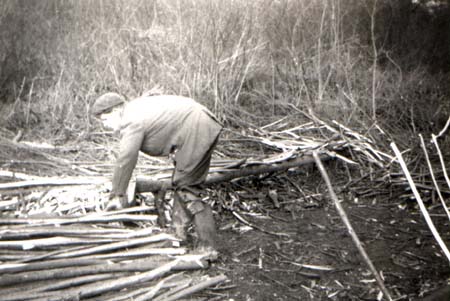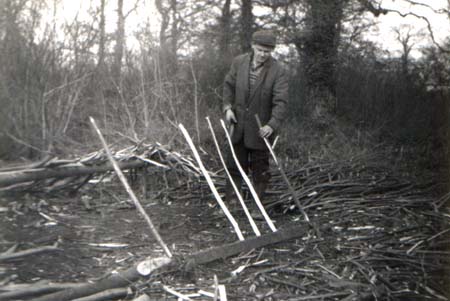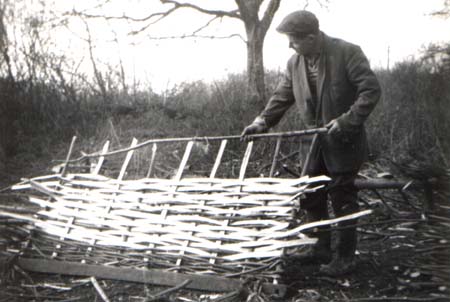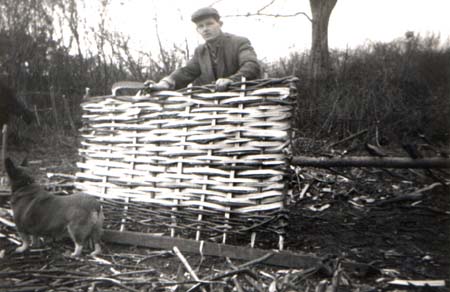|
|
Note that this
article was originally written in 1968 by Mrs. P. Reeks.
|
Mr.
Kerley is another Verwood craftsman continuing in his
father's foot- steps, although he does not make as many
sheep hurdles as his Father did, the reason being that more
and more sheep are wither fenced in their feeding ground or
on free range. A large number of his hurdles are made for
garden partitions and ornamental fences. Some are used on
dual-carriageways to break car head light beams. Mr.
Kerley's father made sheep hurdles for use in Dorset,
Wiltshire and Hampshire. Today Mr, Kerley's sheep hurdles
are mostly used for lambing pens. The hurdles are supported
by wooden "sures" or stakes which are driven into
the ground between each hurdle. A twisted wooden or wire
shackle is used to link the end zales of each hurdle to a
sure. A lambing pen is usually lined with straw bales for
protection against the elements. Sheep hurdles have a space
in the centre called a "Twilly hole", so that when
a shepherd wishes to move the sheep—pen he can carry
several hurdles by threading a ''sure''' through the Twilly
holes.
There are many hazel copses in the Verwood area so
('Mr. Kerley has plenty of raw material. He said that wood,
ten to twelve years old is the best as he can cut a lot of
useable wood when it is at this stage of growth. Hazel
bushes benefit from cutting as they throw up more shoots
each time that they are cut. It is softer and consequently
easier to cut in the summer than if cut in the winter.
Frosts can make it brittle and difficult to work. If willow
is to be used it must be worked immediately after cutting,
as when it dries or is burned by the sun it becomes very
brittle.
I went to visit Mr. Kerley in a hazel copse, and
though it was a bitterly cold morning, he seemed unperturbed
by the weather and was working in a shirt with his sleeves
rolled up. He had been trimming out - cutting legths of
haze1. The smaller pieces had been put into bundles for
"pea sticks", but this wood was only eight years
old. Hence he had not been able to cut as large a quantity
as he had hoped. I asked him why he had not left the wood to
grow more and he replied that the owners had wanted it cut
now, and that if he had not taken the opportunity someone
else would have done so. Also the copse was in a desirable
position close to the road, and could be easily reached by
the hurdle carriers.

Mr. Kerley was working in a well worn part of the
wood surrounded by cut hazel. Some was in heaps; some had
already been selected and placed on a rack. The cross-pole
of the rack had been marked with a chopper at certain spots
these being used as measures. On and partly in the ground
was the frame - a large round log, approximately seven feet
long which was shackled to the ground with twisted wooden
shackles and wooden pegs. The frame had holes, into which
the zale points were placed, the holes having been drilled
with an "auger". This tool drills at an angle,
more efficiently than does a brace and bit.

Mr. Kerley began by putting the zales - the upright
wood - into the frame. Some zales were cloven i.e. unsplit,
others he split into two and some into four, depending on
the thickness of the wood. The wood for zales has to be
fairly straight, and this he split with a cleaving hook. He
told me that the hook point had to be sharp and the blade,
blunt. He cut into the top with the sharp part and split the
wood with the blunt part to prevent cutting his hands. The
zales points were cut with a knobbing (Knobby) hook which
had a ten inch blade and had most of the weight at the head.
Ten zales were put into the frame with any natural
curve curving towards the front, away from him. He then
chose smaller wood to continue the hurdle, picking up the
pieces with the hook to prevent catching hold of thorns, or
in the summer to prevent picking up snakes. Each piece had
the knots or spikes trimmed off, this process being called
"shredding". It was then split beginning
approximately twelve inches from the top and splitting to
the bottom. Mr. Kerley told me that the rods to be woven can
be used cloven or split if the rods are thick.
-
Mr. Kerley began weaving with four bottom
binders or rods leaving the long ends free.
-
Two Johnny rods (the name given to the next
pair of rods) were woven, both being twisted round the
end zale at the left.
-
He twisted the bottom binders round the end
zales next, to form the "big spurs". These
hold the bottom of the hurdle firm.
-
Four or five "backers" (filling
rods) were then woven, being twisted around the end
zale on the right.

-
At this stage Mr. Kerley measured with a
marked stick the width of the hurdle to ensure that it
was being made accurately.
-
If the hurdle is to be a six feet high
hurdle, backers are used from the next rod up to the
top binders. If a sheep hurdle is being made, the
pitch rod is the next rod woven, it is twisted round
the left zale and threaded from the back to the front,
four rods down.
-
Next, a gap called a "Twilly hole"
is left in the weave of a sheep hurdle. Above this are
woven two strong "Twilly rods" which
strengthen the hurdle for the occasions when the
shepherd comes to move the fold.

-
Two or three backers are then woven and
twisted round the right hand zale. As Mr. Kerley
pointed out, this end is then higher than the left
because of the twisted rods.
-
The top "binders" are then woven
with the twists round the left end zale, to help to
level the rods. To level the work completely, a short
stiff rod called the "Stumpy Rod" is woven
from the left left end zale to the third zale from the
right.
-
The "Pitch Rod" is the final rod to
be woven. It is tucked in from the back, four rods
down and twisted round the right end zale, the
opposite way from the other rods, and woven through
the top binders.
-
The uneven ends are then trimmed. As Mr.
Kerley said "trimming requires skill".
One false cut could ruin the hurdle of injure the
craftsman.
Mr. Kerley told me that hurdles have to be made
with a slight curve, but when they are stored they
straighten out. If they were made straight, they would
become curved when stacked.

"A
Completed Fencing Hurdle".
All hurdles are six feet long; sheep hurdles are
three feet high of weaving plus the spike ends. Garden
hurdles can be made up to six feet high. When hurdles are
made, the frame has to be placed in the trench, or the frame
tilted and the hurdle made at an angle.
A great deal of physical strength is needed for the
making of hurdles. All the wood has to be cut and carried to
the working space and when weaving the craftsman has to push
the rods into position with his foot. As the hurdle is built
higher this is done with his knee, usually protected with a
rubber pad.
Mr. Kerley has one son, but it is too early to tell
whether he will carry on the family craft, which also
includes spar making, spars are the wooden staple-like pegs
used to hold the straw in thatching. They are made from
hazel and are of varying lengths according to the type of
thatching required. When thatching a house two feet four
inch spars are used with shorter ones round a chimney. Hay
Ricks need to be thatched using three feet or two feet six
inch spars, and wheat Ricks need three feet six inch spars.
Mr. Kerley makes very few spars today, as he is
almost completely occupied making hurdles. He told me that
to make any profit on spars he needs to be quick and said, "There
should be three chips in the air at once!"
Copyright © P Reeks.
|